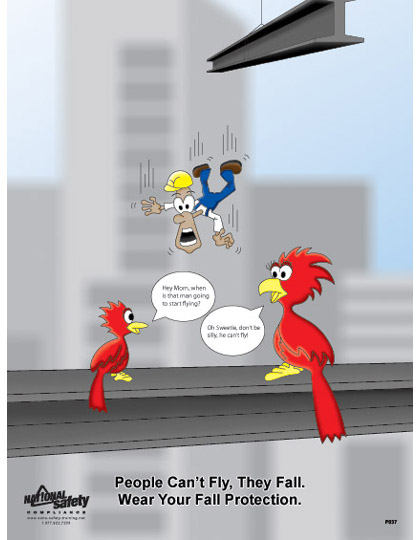One thing that scares the heck out of me is being in high places! It’s weird, because it doesn’t bother me to fly in an airplane, but if I have to climb more than one step on a ladder, my legs just start to fail me! When I look up and see workers building skyscrapers, all I can do is get weak in the knees and hope they are hooked up to something to keep them safe. There are several types of fall protection, so let’s talk about some of them:
- Fall Prevention. This is where the use of handrails or barriers are placed to keep employees from falling. Many have been known to fall under the rails or barriers anyway.
- Fall Protection. Fall restraint from an alternative approach. Fall protection systems that refer to the entire science of protecting employees who have to work far off the ground. Ladder cages are part of fall prevention; however they only work if the person falling off the ladder grabs one of the cage bars.
- Fall Arrest. If someone actually has fallen off a ledge and his body harness catches him some distance away, this is a fall arrest, because it stops the fall in mid-action. However, injuries can still occur. Depending on the length of time a person hangs, serious pooling of the blood system can be caused, possibly damage to the extremities. Other injuries can occur from the arrest jolt.
- Fall Restraint System. Is the actual gear that is used to prevent falling while working at heights. It could be a belt with a hook, or a full body harness and fall speed reduction system with impact buffers. (I think I would want that one!) A proper fall restraint system has a shortened strap, rope, or strap attached to a secure surface, making sure that the worker can’t get too close to a ledge.
- Prevention seems to be the least harmful choice for the best protection, and least costly of all fall protection aspects.

In the construction industry, falling is the #1 killer of employees. In this single industry, there are between 150 to 200 fatalities annually, and more than 100,000 injuries per year because of falls. OSHA has created standards that will better protect workers from falling hazards. These standards require wearing fall protection when you are working over dangerous machinery. Also, if employees are working at or above four feet, they must wear a safety harness and fall protection.
Almost all situations now require a full body harness. These fit around the chest, waist, and legs, offering full support to a person involved in a fall. The lanyard is the lifeline that connects a three-part fall protection system in order to prevent serious injury. The three parts are: the anchor, safety harness and lanyard. Lanyards are designed to bring a worker to a complete stop when falling. OSHA regulates that all ropes, and straps for lanyards should be made of synthetic materials and capable of supporting dead weight of 5,000 lbs.
Studies on ergonomics have become more critical in recent years as workplace safety product designers learn about comfort in an effort to prevent fatigue, reduce injuries, and increase production. Quality features in a fall protection harness include removable tool belts, strong yet light-weight materials, padded backpads, strap adjusters, shoulder pads, three D-rings for back and hips, sliding back D-rings, indoor pads, seat straps with aluminum bars and carry-all bags.
Employers must provide the fall protection for its workers and proper training for its use. The employee is responsible to wear the harness properly as required. This is personal protective equipment that cannot be ignored by those working in high places.